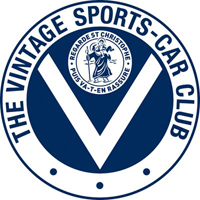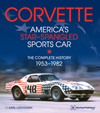|
Printed in the
United States of America |
Corvette -
America's Star-Spangled Sports Car
Price: $24.95
|

Vintage Sports Car-Club Bulletin - Autumn 2014
There is, about books written by Karl Ludvigsen, a degree of certainty that has grown over the years for the motoring bibliophile, the mythical man on the Clapham omnibus with an interest in reading about motor cars, who can be assured that a book written by this author will be thoroughly researched, well written and entrusted to a publisher to whom quality is important and Corvette is certainly no exception. Fledgling authors might consider that Karl Ludvigsen's commitment to research, in this case, is not generally attainable since the author worked, in the early years of his career, at GM Styling, went to Car and Driver as Editor and returned to GM in 1962 to work with styling Vice President Bill Mitchell and also with Zora Arkus-Duntov, 'The Legend Behind Corvette', and Clapham man, as an arbiter of what is reasonable, might have to agree but readers of this book will truly benefit from that insight.
Every once in a while there will be a book which, while not on a subject absolutely central to a readers interests, attracts because of its quality and how reading a few lines draws the reader in to a story about which he knows little; for the vintagent Corvette will be just such a book. The chapter on the chassis design is a case in point and is a fascinating insight into the reasoning and constraints that led Maurice Olley down the path he chose back in 1952 when his Chevrolet R&D Department was given full responsibility for the new American sports car's chassis design. It is worth noting here that we are talking about 62 years ago and, in VSCC terms, the 'vintage period finished only 22 years before that and there is a clear path from 'vintage' thinking to 'modern' as it was back then. That the author had access to all the available information and many of the people concerned is abundantly clear and, despite, the weight and page count, the book is hard to put down as each stage of the story unfolds; disappointing sales and lacklustre performance led to a change to V8 power, denoted on 1955 cars by a modification to the script on the sides to read "cheVrolet" but power hungry Americans had to wait 'til 1956 for the real McCoy, restyled with the two tone swages back from the front wheel arches and now with real performance including a 15.9 seconds quarter mile with a terminal speed of 91 mph.
Interspersed through the book are sidelights, highlighted by being printed on a dark cream coloured paper, on various aspects or personalities in Corvette history. The first such section, three pages in length, explains the origins of the name go back to the Flower-class corvettes that did so much to protect the shipping lanes between America and Britain during the Second World War. The author does not shy away from telling the reader that one Canadian veteran recalled "all corvette sailors remember their ships as a source of numbing fatigue and indescribable discomfort". Not, perhaps, what GM in tended for their new competitor for the Jaguar XK120? In fact, the book pulls no punches in telling it as it was, the Corvette, warts and all, and just what was needed to cure the problems and keep the Corvette at the forefront of performance cars available at a reasonable price in the States. The racing history is covered in detail, including developments that helped the road car programme, and this undoubtedly helped to push sales over 10,000 cars for the 1960 model year, when the wayward rear suspension had been somewhat tamed and 270 bhp was available.
As was the way in Detroit each new model year needed to offer something different but surely the strangest vehicles of all is included in the coachbuilders 'cream' sidelight with a colour picture of the Oscar Meyer Weinermobile, a promotional vehicle in the shape of a hot dog sausage styled by Gordon Kelly, who also styled a one off Corvette, to be built by Vignale in Turin, that survives to this day but, as is often the case, the standard car looks better. There is so much to be learned from this book and the exploded views, cutaway drawings and engineering sketches add so much to the pleasure of reading it, particularly if engineering details and the internal components of engines and suspension are what get your interest.
Once again, a book from Karl Ludvigsen achieves the status of being the standard work on the subject and it is hard to see how any book on the first thirty years of the Corvette could replace this work that is both a joy to read and incredibly detailed. The book is almost monumentally heavy with 784 pages and a coated paper would have increased the weight but a gloss finish just gives the edge to the pictures. Since it is printed on acid free paper the slightly matte finish may be all that's available and the quality of the printing is certainly good with the book produced in the United States.
Corvette can be enthusiastically recommended to our readers and, as the advertising blurb says, this is a book for anyone who ever drove a Corvette or wanted to! Perhaps readers who fit neither category will find themselves wanting to after reading the book but that could prove more costly than the price of the book. Both Karl Ludvigsen and Bentley Publishers are to be congratulated on a job well done. There is a rumour of a second volume to bring the story up to date but that might require the installation of an industrial bookshelf.

Review from and courtesy of Vintage Sports Car-Club Bulletin - Autumn 2014
![[B] Bentley Publishers](http://assets1.bentleypublishers.com/images/bentley-logos/bp-banner-234x60-bookblue.jpg)

